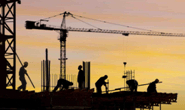Steel Markets

Nonresidential Construction Spending Down Again in June
Written by David Schollaert
August 2, 2021
Construction sectors continued to diverge in June, reported the Associated General Contractors of America (AGC). Although residential construction increased month on month and when compared to the same year-ago period, nonresidential construction spending fell again. The nonresidential declines include a steep drop in spending on highway and street projects, prompting the AGC again to urge Congress to expedite a bipartisan infrastructure bill.
“The pandemic has created a tale of two construction industries, a residential market where demand continues to surge and a nonresidential market that is struggling to gain traction,” said Stephen Sandherr, AGC’s CEO. “The federal government has a real opportunity to boost nonresidential construction by passing the bipartisan infrastructure measure as quickly as possible.”
Construction spending in June totaled $1.55 trillion at a seasonally adjusted annual rate, an increase of 0.1% from May, and up 8.2% from the pandemic-depressed rate in June 2020. Once again, residential construction saw monthly and year-over-year gains while nonresidential construction spending lagged. The residential construction segment climbed 1.1% for the month and 28.8% year-over-year. The nonresidential construction segment fell by 0.9% compared to May and 6.6% compared to June 2020.
Private nonresidential construction spending fell 0.7% from May to June and 6.0% since June 2020, with year-over-year decreases in all 11 subsegments. The largest private nonresidential category, power construction, fell 1.9% year over year and 1.2% from May to June. Among the other large private nonresidential project types, commercial construction – comprised of retail, warehouse and farm structures – retreated 2.1% from one year ago and 0.2% for the month. Manufacturing construction fell 0.7% from a year earlier and 1.1% from May. Office construction decreased 9.1% year over year and by 0.1% compared to May.
Public construction spending plunged 7.5% year-over-year and 1.2% for the month. Among the largest segments, highway and street construction declined 7.6% from a year earlier and 5.3% compared to May 2021. Public educational construction decreased 9.1% year over year and 0.8% in June. Spending on transportation facilities fell 5.7% over 12 months but was up 1.1% in June.
The AGC noted that the new bipartisan infrastructure measure proposes to invest more than $1.2 trillion to build the nation’s roads, bridges, transit systems, airports, ports, and waterways, drinking water and wastewater systems, energy infrastructure and more. Congress should pass the measure as quickly as possible to have the broadest impact on creating new construction career opportunities, the association said.
“It would be a shame if certain members of Congress were to hold new infrastructure investments, and the job opportunities they create, hostage to impose unrelated partisan measures that would undermine the economic recovery,” Sandherr added.

David Schollaert
Read more from David SchollaertLatest in Steel Markets

CMC looks beyond Arizona micro-mill woes to long-term viability of construction mart
Despite the economic and geopolitical upheaval of the last five years, CMC President and CEO Peter Matt points out that the construction market has been an essential element of the way forward.

US importers face stricter rules under revamped S232 tariffs
“CBP expects full compliance from the trade community for accurate reporting and payment of the additional duties. CBP will take enforcement action on non-compliance," the agency said in a March 7 bulletin.

Steel exports rebound in January
US steel exports recovered to a five-month high in January after having fallen to a two-year low in December. This growth follows four consecutive months of declining exports.

Construction spending drops marginally in January
Construction spending edged down slightly in January, slipping for the first time in four months. The US Census Bureau estimated spending at a seasonally adjusted annual rate of $2,196 billion in January, down 0.2% from December’s downward revised rate. The January figure is 3.3% higher than a year ago. January’s result, despite the slight erosion, […]

HVAC equipment shipments slow in December but strong annually
Shipments of heating and cooling equipment in the US fell to an 11-month low in December, according to the latest data released by the Air-Conditioning, Heating, and Refrigeration Institute (AHRI).
